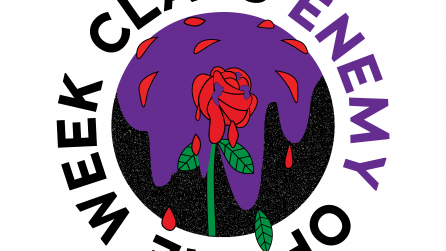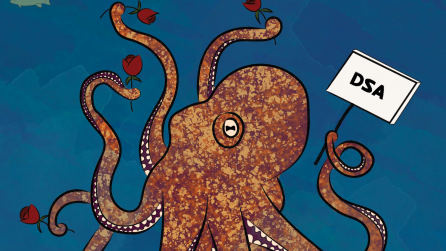Reflections on This Summer
Like many cities, Chicago saw an explosive number of direct actions this summer. There were a variety of planned and spontaneous protests following the murders of Breonna Taylor, George Floyd, and Tony McDade. Car caravans demanded the release of incarcerated folks at a unique risk of contracting COVID-19. Rallies from the Chicago Teachers Union uplifted their refusal to teach in-person amidst a pandemic. And marches spotlighted the lack of support for unemployed people. These actions required a tremendous amount of bravery and compassion for others as protestors navigated not only the risk of COVID-19 exposure, but also extreme violence and abuse from police.
Chicago DSA members attended these protests both independently and representing the organization. The Chicago Afrosocialists & Socialists of Color Caucus and the chapter itself co-hosted numerous actions throughout the summer with our organizational allies. One of the ways that members supported actions was by volunteering as safety marshals. After the downtown May 30 protest where hundreds were arrested, and a June 5 protest where safety marshals and bicyclists made a bike wall that held back police as protestors dispersed, action organizers started spending more time recruiting safety marshals—particularly those with bikes.
I learned a lot volunteering for actions throughout summer as a safety marshal with my bike. I started to see the same people and we began informally debriefing with one another about which tactics were successful and unsuccessful. Action organizers often hosted in-person or virtual trainings to prepare us ahead of time, helping us better execute their planned tactics. Consistently, marshals were reminded that their role was not to police the actions of protestors, but rather to keep the crowd together and safe. These trainings taught me the value of having a group of volunteers ready to jump in during moments of conflict and to serve as a calm and de-escalating presence during protests.
While these marshal groups proved invaluable, they weren’t perfect. Marshals were gathered ad-hoc by different organizations, often in a group chat used for a specific protest. While there were usually repeat volunteers, each group often had a large number of new marshals entering situations more tense than they were prepared for. It was also rare to have a formal debrief with marshals and organizers to discuss what they witnessed or experienced, though these debriefs did sometimes take place after actions that had become heated. The lack of a consistent group made it difficult for marshals to learn and grow together, and to respond to increased threats from CPD, the National Guard, and counter-protesters.
At some actions, conflicts emerged due to lack of clear communication between marshals and organizers. During others, some newer marshals felt unprepared for how to respond to the severity of police brutality. There were also challenges in communicating the values of marshalling (notably, not policing the actions of others and remaining calm in the face of hecklers) when recruiting support from general protestors during actions. Often it was hard for marshals to learn from what went well and what went poorly at actions, without any systems in place for accountability. I share these challenges not to critique anyone—everyone involved at these actions was learning on the fly and responding to increasingly tense environments. But it is valuable for us to look back on this summer as we prepare for the months ahead of us.
Chicago DSA and the Red Rabbits
After reflecting on this summer and the challenges I’d experienced as a marshal, I thought back to an article from Democratic Left entitled “Walk, Rabbit, Walk.” In response to provocations from counter-protestors at DSA actions and meetings, NYCDSA formed the Red Rabbits to train up a group of safety marshals for their chapter. The national Red Rabbits Working Group also provides trainings for all chapters on de-escalation, preparing for actions, and responding to disruptions (demonstrated in this recent article). With this model, we submitted a proposal to the CDSA Executive Committee to establish our own Red Rabbits Marshaling & Safety Committee. The EC recently approved this new committee, and I’d like to outline some notable things we’ve accomplished and have in the works.
At the root of our work with the Chicago Red Rabbits is the understanding that the depth and strength of our relationships is what keeps us safe, both in the chapter and in the streets. CDSA members who have been active for at least 3 months are eligible to join the Red Rabbits Marshaling & Safety Committee. This prerequisite is not a matter of gatekeeping, but makes sure new members have ample opportunity to build relationships within the chapter, participate in political education, and get plugged into chapter campaigns. We currently have 3 teams: marshals, administration/communication (admin), and information security (info sec). CDSA members don’t even have to volunteer to marshal in-person for direct actions—there is plenty of work to be done from home. We’ve structured this intentionally so that all members can participate in chapter safety, regardless of their ability, risk level, or health status.
Our admin and info sec teams help us communicate across the committee clearly and assess that we’re using all digital platforms securely. During actions, volunteers from our admin team are available at home with a list of emergency contacts for marshals to make sure everyone returns home safe after a protest. All new volunteers have a 1-on-1 with their team’s lead, and marshals all go through a mandatory, one-time Marshaling 101 onboarding. This training not only covers marshaling logistics, but also includes political education, and an emphasis on the importance of solidarity and camaraderie. We also encourage our marshals to recruit protestors with bikes from the crowd to walk the edges of the march with us. This, paired with safety announcements during rallies, lets the entire crowd know we as a collective have to take responsibility for security, not just safety marshals.
Going forward, our hope is that the Red Rabbits can be relied upon as a tool by our chapter more widely. Any time one of our CDSA campaigns hosts a direct action, the organizers will be able to easily contact our committee and request the presence of marshals. As our committee develops, we also hope to serve as a resource on matters of security more broadly—for example, having our information security team available to consult with campaigns on their use of digital tools and their security protocols. Eventually, we’d also like to be able to provide the Red Rabbits as a tool to our organizational allies in Chicago—in the same way that anyone can contact the National Lawyers Guild Chicago chapter to provide legal observers at a protest, we hope that Red Rabbits can scale ourselves up to serve as a similar resource for direct actions across the city.
Looking Forward
It goes without saying that we face numerous potential crises in the coming months. We may see mass action in the streets in response to the election (either from the left, the right, or both), we’re facing a second wave of COVID-19 infections, the economy shows signs of another downturn, and we’re seeing violent responses from right-wing and white supremacist counter-protestors across the country. We can’t guarantee that mass action in the streets will continue through the colder season, but the conditions for it to happen will certainly be in place. And even if this winter doesn’t see mass direct action, it’s certainly likely to happen when warm weather returns.
This summer caught many DSA chapters off-guard, both with the impact of the pandemic and the uprising for Black lives. Though we might not have been able to predict these situations before, we have the opportunity at least to anticipate some of the scenarios that could pan out in the following months. What this summer taught us is that it is far preferable to have plans and systems in place for how chapters support direct actions before spontaneous uprisings, and not during. Rural chapters should be uniquely prepared to respond to the results of the election, and urban chapters should step up to provide material and training support.
By nature, uprisings are unpredictable. We can’t wholly plan or prepare for the next surge of political engagement that will match or surpass the summer of 2020. Nevertheless, DSA chapters should assess the infrastructure that they have in place to increase safety for protestors, whether during their normal campaign work or during national moments of unrest. Chapters don’t need formal Red Rabbits programs to host trainings for their members on protest safety and general security. Whether you’re interested in starting up your own local Red Rabbits program for your chapter, or just want to host a protest safety training for your members, feel free to email us at redrabbits@chicagodsa.org to connect.




